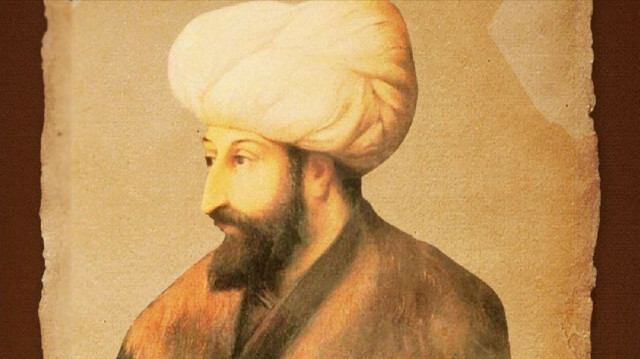
7th Ottoman Sultan's sophisticated character and achievements in many domains make his legacy long-lasting
Mehmed II is pertinently recognized as Mehmed the Conqueror in the world, and Abu al-Feth (The Father of the Conquest) in the wider Islamic world, owing to his conquest of Istanbul, which was the capital of the Eastern Roman Empire and one of the cultural, economic, political and religious center cities of the world.
His conquest of Istanbul on May 29, 1453, a milestone in the history of the Ottoman Empire and world history, has remained what made him be remembered for hundreds of years. However, his achievements in many other domains as builder, administrator, visionary, a man of letters, science enthusiast and patron of art should be overshadowed by his brilliant military campaigns that extended the empire as far as southern Italy in the west, Crimea peninsula in the north and central Anatolian plateau in the east.
Istanbul, not being able to recover from the city's sack by Latins in 1204, was far from being a prosperous, populated imperial city as it used to be before when it was conquered in 1453. To populate the town, Mehmed transferred Turcoman tribes from central Anatolia and encouraged Greeks from Foca, Argos, Thasos, Trabzon, Samothrace, Lemnos and Mytilene, and Jews from Caffa, Crimea to settle in Istanbul by giving them favorable treatment in administration, land and financial affairs. [1]
Furthermore, much-needed rebuilding projects were immediately undertaken after the conquest to restore the deprived city to its glorious days. City walls were repaired, in Yedikule, a citadel was constructed, and Topkapi Palace's construction was started. Later, in 1459, he introduced a set of new measures to stimulate the repopulation and prosperity of Istanbul. He instructed his dignitaries to establish a building complex containing a waqf-Islamic charitable endowment in different quarters of the city- a public kitchen, a mosque, and various commercial facilities like inn and market.[2] By the early sixteenth century, Istanbul had become the largest city globally with a population of around 400,000, which included a vast number of Greek, Armenians, and Jews.[3]
Sultan Mehmed's imperial perspective included all ethnic and religious constituents of the state machinery and their peaceful co-existence. Mehmed laid the foundations of the Millet system, under which different denominations and religions of the empire ruled themselves according to their own religious law.[4] He also employed many from notable Byzantine families, including Mesih Pasha, last Byzantium Empire Constantine XI Palaiologos's nephew, and Mahmud Pasa from the Byzantine Angelos family, in the Ottoman civil and military bureaucracy.[5] Similarly, prominent Islamic scholars of the time, like Akshamsaddin and Mullah Gurani, were among the influential tutors and advisers of Mehmed.
Moreover, Sultan Mehmed was passionate about Classical and contemporary literature, history and science. This passion was crowned in his work for building a vast multilingual library that contained over 8000 manuscripts in Persian, Ottoman Turkish, Arabic, Latin, and Greek, among other languages. [6] He invited some prominent Renaissance artists, including Constanzo da Ferrara and Gentile Bellini, who painted a famous portrait of his, to the Ottoman court. [7] Being a poet himself, Mehmed also wrote lyrical poems by the pen-name Avni and built a divan- a collection of poems written in the traditional style of classical Ottoman literature.
[1] Feridun M. Emecen, Osmanli Imparatorlugunun Kurulus Ve Yukselis Tarihi,1300-1600 [ History of Foundation and Rise of the Ottoman Empire, 1300-1600] (Istanbul: Turkiye Is Bankasi Kultur Yayinlari,2015),141-2.
[2] Halil Inalcik, “The Policy of Mehmed II toward the Greek Population of Istanbul and the Byzantine Buildings of the City,” Dumbarton Oaks Papers, 1969/1970, Vol. 23/24 (1969/1970), 236-7.
[3] Omer Lutfi Barkan,” Osmanlı İmparatorluğunda Nüfus ve Arazi Sayımları ve İstatistikleriyle İlgili Defter -i Hakaniler,” [Population and Land Registration Records in the Ottoman Empire], I.U Iktisat Fakultesi Mecmuasi, no.2 (1970)
[4] Karen Barkey and George Gavrilis, “The Ottoman Millet System: Non-Territorial Autonomy and Its Contemporary Legacy,” Ethnopolitics 15, no.1 (2016):24-42.
[5] Theoharis Stavrides, The Sultan of Vezirs: The Life and Times of the Ottoman Grand Vezir Mahmud Pasha Angelovic (1453–1474), (Leiden: Brill,2001).
[6] Gulru Neciooglu, “Visual Cosmopolitanism and Creative Translation: Artistic Conversations with Renaissance Italy in Mehmed II’s Constantinople," Muqarnas Online 29, no.1 (2012):1-81.
[7] Julian Raby,”A Sultan of Paradox: Mehmed the Conqueror as Patron of the Arts,” The Oxford Art Journal 5, no.1 (1982):4.

